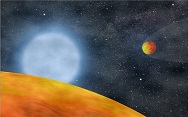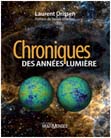2023 | 2022 | 2021 | 2020 | 2019 | 2018 | 2017 | 2016 | 2015 | 2014 | 2013 | 2012 | 2011 | 2010 | 2009 | 2008 | 2007
News 2011
Discovery of a planetary system 3900 light years from Earth
(2011-12-21)
The company ABB will build a novel astronomical instrument in collaboration with CRAQ researchers
(2011-11-21)
Crab pulsar beams most energetic gamma rays ever detected from a pulsar
(2011-10-06)
First 3-Dimensions atmosphere models for white dwarfs
(2011-08-12)
The astrophysicist Laurent Drissen publishes the collection of his news chronicles at the show "Les Années Lumières"
(2011-04-22)
Five astrophysicists from Québec observe carbon-atmosphere white dwarf stars with the Hubble Space Telescope
(2011-04-14)
An interactive journey in the Universe
(2011-02-01)
This web site is for Microsoft Internet Explorer and Firefox.

 Researchers from the Université de Toulouse and the Université de Montréal detected two Earth-size planets orbiting an old star which just entered the red giant phase. This planetary system is located near the Cygnus and Lyra constellation. The discovery, which results will be published in the prestigious journal Nature, should shed light on the evolution of planetary systems.
Researchers from the Université de Toulouse and the Université de Montréal detected two Earth-size planets orbiting an old star which just entered the red giant phase. This planetary system is located near the Cygnus and Lyra constellation. The discovery, which results will be published in the prestigious journal Nature, should shed light on the evolution of planetary systems. A $M2.3 contract from Université Laval will allow for the company ABB to build a new optical instrument for astrophysical research to improve our understanding of the formation of galaxies and stars, as well as the evolution of the Universe.
A $M2.3 contract from Université Laval will allow for the company ABB to build a new optical instrument for astrophysical research to improve our understanding of the formation of galaxies and stars, as well as the evolution of the Universe. New findings from VERITAS Collaboration challenge theoretical models of pulsar emission. Astrophysicists have detected pulsed gamma-ray emission from the Crab pulsar at energies far beyond what current theoretical models of pulsars can explain.
New findings from VERITAS Collaboration challenge theoretical models of pulsar emission. Astrophysicists have detected pulsed gamma-ray emission from the Crab pulsar at energies far beyond what current theoretical models of pulsars can explain. A team of astrophysicists from Quebec and Germany, led by members of the CRAQ at the Université de Montréal, resolved a 20-years old challenge for the study of white dwarfs stars. White dwarfs are "dead" stars, with a core that stopped producing energy via thermonuclear reactions, like normal stars do. They are very compact object with a mass comparable to that of our Sun, but with a size comparable to the Earth. As a consequence, they are extremely dense and the gravity on their surface is more than 100 000 larger than on the surface of the Earth.
A team of astrophysicists from Quebec and Germany, led by members of the CRAQ at the Université de Montréal, resolved a 20-years old challenge for the study of white dwarfs stars. White dwarfs are "dead" stars, with a core that stopped producing energy via thermonuclear reactions, like normal stars do. They are very compact object with a mass comparable to that of our Sun, but with a size comparable to the Earth. As a consequence, they are extremely dense and the gravity on their surface is more than 100 000 larger than on the surface of the Earth. Laurent Drissen, professor at the physics, physical and optics engineering department of the Université Laval and member of the CRAQ, re-wrote, completed and updated his news chronicles that he presented for more than 10 years to the audience of the show "Les Années Lumières", on the first channel of Radio-Canada. He provides a fascinating book explaining the most important astronomical events and discoveries of the past decade.
Laurent Drissen, professor at the physics, physical and optics engineering department of the Université Laval and member of the CRAQ, re-wrote, completed and updated his news chronicles that he presented for more than 10 years to the audience of the show "Les Années Lumières", on the first channel of Radio-Canada. He provides a fascinating book explaining the most important astronomical events and discoveries of the past decade. A team of researchers composed of astrophysicists from Québec, and led by Patrick Dufour, postdoctoral research at the Université de Montréal (UdeM) and member of the CRAQ, analyzed data recently obtained from the Hubble Space Telescope with its new instrument, the Cosmic Origin Spectrograph (COS). The work of the researchers (from the UdeM, the University of Colorado, and the Space Telescope Institute in Baltimore), confirmed the luminosity variations of three stars already observed with ground telescopes. They also discovered a new member of the pulsating white dwarf subgroup, for the first time with observations from space.
A team of researchers composed of astrophysicists from Québec, and led by Patrick Dufour, postdoctoral research at the Université de Montréal (UdeM) and member of the CRAQ, analyzed data recently obtained from the Hubble Space Telescope with its new instrument, the Cosmic Origin Spectrograph (COS). The work of the researchers (from the UdeM, the University of Colorado, and the Space Telescope Institute in Baltimore), confirmed the luminosity variations of three stars already observed with ground telescopes. They also discovered a new member of the pulsating white dwarf subgroup, for the first time with observations from space. The group ECP, in collaboration with the Centre de Recherche en Astrophysique du Québec (CRAQ), is proud to announce the launch of the website www.dubigbangauvivant.com. With the participation of Hubert Reeves and Jean-Pierre Luminet, the website is an invitation to discover the most recent advents and breakthroughs of astronomy and cosmology. With the support of breathtaking images, 2D and 3D animations, the website will immerse you in an interactive astronomical experience from the formation of the Universe to the apparition of life on Earth, from the Observatoire du Mont-Mégantic to the future very large telescopes. With such a tight bound to our cosmic history, there are no more doubts: we are made of star dust…
The group ECP, in collaboration with the Centre de Recherche en Astrophysique du Québec (CRAQ), is proud to announce the launch of the website www.dubigbangauvivant.com. With the participation of Hubert Reeves and Jean-Pierre Luminet, the website is an invitation to discover the most recent advents and breakthroughs of astronomy and cosmology. With the support of breathtaking images, 2D and 3D animations, the website will immerse you in an interactive astronomical experience from the formation of the Universe to the apparition of life on Earth, from the Observatoire du Mont-Mégantic to the future very large telescopes. With such a tight bound to our cosmic history, there are no more doubts: we are made of star dust…